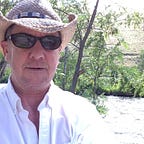I never mastered the single tear, restrained emotion in one small display of feeling and vulnerability. I tend to be a guy whose emotions move up and out through my body. As a kid, I was either frozen or explosively angry and defensive, a pattern modeled by my Dad. Except, in his frozenness he was obsequious, hands folded behind his back, trying to please. I adapted the try-to-please mode to a certain degree but mixed in a healthy dose of self-preservation and personal discipline as modeled by my mother. My father, by the time I was a kid well on his way to dying, gave me my first adult book. Treasure Island. He passed on encouragement to pursue my writing, to tell the story, no matter what.
I took on defensiveness, first, in my mid-twenties, shortly after my father passed. It took me a while to hear I was defensive. People could point me out as being defensive, but I had to train my ear to hear the tones. Finally, I heard them. Next, I had to train myself to feel defensiveness in my body. A bracing, fists up kind of gesture. From there I mapped the story, took a trek into feelings below the surface of defensive. There was confusion, doubt, frozen. I wasn't sure what was happening and didn’t know what to do. These feelings seemed linked to my father, and I didn’t like them. Inevitably, anger followed. Anger always seemed like a good tool. It got attention fast, could be used for power and authority. “Listen to me!”
As I got in better story mapping shape, my treks into underlying feelings got more interesting and painful. Part of the discomfort was crying. I had never been a crier and allowing emotional tears to spill from my eyes triggered off resistance. But the tears wanted out. I practiced a story mapping technique, Silent Scream, in the mirror. This allowed me to dramatically vent my anger in silent screams of rage. I filled my whole body with emotional expression. As a consequence, my mouth relaxed easier into an expression of weeping and was better able to connect with my breathing.
The bridge between crying - face tears -and weeping is the act of breathing. Instead of resisting the tears, open the mouth and allow the tears to emerge from the throat. Breathe deeper and the tears come from the chest. You are weeping. Weeping is more about sadness leading to grief. Face tears can be ones of rage, frustration, hurt, but not all of them lead to a deeper feeling of sadness. Feelings of heartbreak. True weeping feels good. It isn’t a place of self-pity or desolation so much as aligning with loss, being with yourself for a moment of acknowledgment. Even if your parents were not able to pass on a sense of comfort within weeping, you can get in shape to do it.
The next station after weeping is sobbing, and from there you can prepare for a trek into body sobbing. Sobbing comes from the belly and expresses a story of devastation. Feelings of abandonment, being unheard, shamed, annihilated. It’s like a geyser erupting from your very depths and acquaints you with unreleased emotion. It can be a disquieting experience, not for the faint of heart.
The best place to trek to, however, is body sobbing. You descend from face crying to weeping to sobbing, and follow the breath down into the pelvic bowl, your absolute core, and allow the body to sob. It is a form of shake out, a method animals use to shake off trauma, as in being attacked, a method humans use infrequently and poorly at that. When the body sobs, it feels like immense, pleasurable waves rippling through the muscles. The spirit wailing, the earth mourning the uprooted trees. Your very being, your body, your soul and the spirits of those who have gone before you and are yet to come, shake off the hurt. You are left gently on the shore, comforted, refreshed, ready to go on and live life on its own terms.
Tulio from El Dorado is the story of treasure island. The book my father gave me. My father wept in the final months before he died. He wept and scribbled in inconsolable frustration and pain. Not something a fourteen-year-old kid wants to see. He was not able to pass on examples of sobbing and certainly not body sobbing. He didn’t find his way to shaking off the traumas locked into his body. But I picked up where he left off and have completed the training. I got in shape to body sob, and I can pass on to those who come behind me my methods. I guess my father would have been proud.
